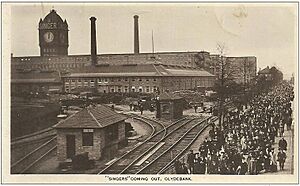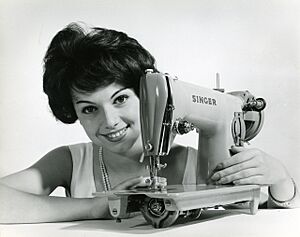Singer Corporation facts for kids
 |
|
| Industry | Manufacturing |
|---|---|
| Founded | 1851 in New York City |
| Founders |
|
| Headquarters | Nashville, Tennessee, U.S. |
| Products | Sewing machine Upholstery |
| Owner | SVP Worldwide |

The Singer Corporation is a famous American company that makes sewing machines for homes. It was started in 1851 by Isaac M. Singer and a lawyer named Edward C. Clark in New York City.
At first, the company was called I. M. Singer & Co. Later, it changed its name to Singer Manufacturing Company in 1865 and then to The Singer Company in 1963. Today, its main office is in Nashville, Tennessee. Singer built its first big factory for making many machines quickly in 1863 in Elizabeth, New Jersey.
Contents
History of Singer
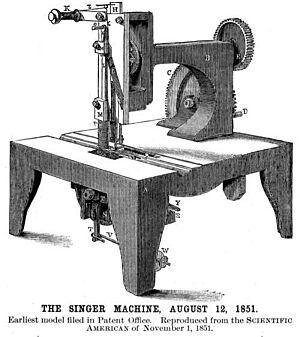
Singer's first sewing machine design was very useful for everyday home use. It used a special needle with an eye at the point and a "lock stitch," which were ideas from Elias Howe. Howe actually sued Singer in 1854 because Singer used his ideas, and Howe won the case.
In August 1851, Isaac Singer received a special permission, called a patent (number 8294), for his improved sewing machine. This machine had new features like a round wheel to move the fabric, a way to control the thread, and gears to power it.
Singer gathered enough patents (rights to inventions) to start making many machines at once. By 1860, his company was the biggest sewing machine maker in the world!
In 1885, Singer built a new factory in Kilbowie, Scotland. This factory made a new type of sewing machine that was better than older designs. Singer started selling its machines all over the world in 1855 and even won a top prize at the Paris World's Fair that same year. In 1910, the company showed off the first working electric sewing machine. Singer was also smart about selling. They were one of the first companies to let people pay for machines over time, in small amounts.
Early Sales Success
Singer's sewing machines became very popular very quickly. Here's how many machines they sold in their early years:
| Year | 1853 | 1859 | 1867 | 1871 | 1873 | 1876 |
|---|---|---|---|---|---|---|
| Units Sold | 810 | 10,953 | 43,053 | 181,260 | 232,444 | 262,316 |
By 1876, Singer announced they had sold two million sewing machines in total! They even put the two millionth machine on display in Philadelphia.
Singer in Scotland
In 1867, Singer decided that many people in the United Kingdom wanted their sewing machines. So, they opened a factory in Glasgow, Scotland. George Ross McKenzie, a leader at Singer, chose Glasgow because it had iron industries, workers who would work for less money, and good shipping routes.
The demand for machines was so high that the Glasgow factory couldn't make enough. By 1873, a bigger factory was built in Bridgeton, Glasgow. At that time, Singer employed over 2,000 people in Scotland, but they still needed to make more machines.
In 1882, McKenzie, who was about to become the President of Singer, started building an even bigger factory in Kilbowie, Clydebank. This huge factory was built on 46 acres of land. It had two main buildings, each 800 feet long and three stories high, connected by three smaller sections. Above the middle section was a 200-foot-tall clock tower with the "Singer" name on it, which could be seen for miles!
The factory had almost 3 miles of railway tracks inside to connect different parts, like the boiler room and shipping area. It was designed to be fireproof with water sprinklers, making it one of the most modern factories in Europe at the time.
With nearly a million square feet of space and almost 7,000 employees, the Clydebank factory could make about 13,000 machines every week. This made it the largest sewing machine factory in the world! In 1905, the U.S. Singer Company even created a special company in the UK called Singer Manufacturing Company Ltd.
The factory kept growing, and its buildings were made even taller, up to 6 stories high. In 1907, a train station was built right next to the factory to help workers get there from nearby towns and Glasgow.
In 1911, about 10,000 workers went on strike at the Singer factory. This "Singer Strike" happened because 12 women workers were upset that three of their co-workers were fired, but the remaining workers still had the same amount of work without extra pay. This strike was important because it showed the rights of women workers and the power of "collective bargaining," where workers join together to ask for better conditions.
During the First World War, the Singer Clydebank factory stopped making sewing machines. Instead, it made weapons and war supplies for the government. The factory made millions of artillery shells, parts for planes, grenades, and rifle parts. By the end of the war, about 70% of its 14,000 workers were women.
From 1884 to 1943, the Kilbowie factory produced around 36 million sewing machines. Singer was the world leader, selling more machines than all other companies combined. In 1913 alone, the factory shipped 1.3 million machines.
In the late 1950s and 1960s, the Clydebank factory changed a lot. In 1958, Singer moved 40% of its American production to Clydebank to save money. From 1961 to 1964, the factory was updated with £4 million. It stopped making heavy cast iron machines and started making lighter aluminum ones for Western countries. As part of this update, the famous Singer Clock Tower was taken down in 1963.
At its busiest in the mid-1960s, Singer employed over 16,000 workers. But by the end of that decade, the company started letting people go. Ten years later, only 5,000 workers remained. Because of money problems and fewer orders, the world's largest sewing machine factory closed in June 1980. This ended over 100 years of sewing machine production in Scotland. The factory buildings were torn down in 1998.
Selling Machines Before the World Wars
The Singer sewing machine was one of the first complicated machines to be sold to many people. It wasn't the very first sewing machine, and its patent in 1851 led to a legal fight with Elias Howe, who invented the "lockstitch" machine. Eventually, the big sewing machine companies agreed to share their patents.
Singer's marketing often showed women using the machines at home. This made people think of good qualities like being hardworking and careful. Even though the sewing machine made sewing much easier than doing it by hand, it mostly helped people who sewed for their families. People who sewed for a living still didn't earn much money, and their wages sometimes dropped because machines made sewing faster.
Singer also offered ways for people to buy machines even if they didn't have all the money at once. They had "credit purchases" and "rent-to-own" plans. This meant people could rent a machine, and their rental payments would count towards buying it later. Singer also sold machines all over the world by sending salespeople door-to-door to show how the machines worked and to sell them.
Singer During World War II
During World War II, Singer stopped making sewing machines. Instead, they made weapons for the government. Factories in the United States made parts for Norden bomb sights and M1 Carbine rifles for the American military. Factories in Germany also made weapons for their country's armed forces.
In 1939, the U.S. government asked Singer to plan how to build M1911A1 pistols. In April 1940, Singer received an order to make 500 of these pistols. This was part of a program to teach companies without experience in making guns how to do it.
Singer delivered all 500 pistols to the U.S. government. Even though Singer couldn't make 100 guns a day as the government wanted, the War Department was very impressed with the quality of their pistols. So, they asked Singer to make parts for navigation and targeting equipment instead. The machines and tools for making pistols were then moved to other companies. Because only 500 Singer pistols were made during World War II, they are very rare and valuable today. In 2017, one of these pistols sold for $414,000 at an auction!
In December 1940, Singer also got a contract to make the M5 Antiaircraft Director. This was a device used to help aim anti-aircraft guns.
After the War
Singer started making sewing machines again in 1946. In 1957, they introduced one of their most popular and high-quality machines, the 401 Slant-o-Matic.
In the late 1960s and early 1970s, Singer helped pay for rock and roll concerts to advertise their products, including their own record players. In 1968, Singer sponsored a TV special called "Singer Presents ... Elvis," which is now famous as the '68 Comeback Special.
Singer in Asia
Singer started its business in Sri Lanka in 1877 as a branch of the U.S. company. In 1957, Singer began selling home appliances in Asian markets, not just sewing machines. By 1963, a company called Singer Industries (Ceylon) PLC was set up to put together sewing machines and make cabinets and stands for them.
Singer Sri Lanka became a public company in 1974 and was listed on the stock exchange in 1981. They started making refrigerators in 1988. In 1998, the first Singer Mega store opened, and in 2001, the company launched its online shopping website, which was a first for a home appliance company in Sri Lanka.
Singer Finance was started in 2004 and began taking money from the public in 2005, offering new financial services. In 2010, Singer started using a new online system to manage its business. In 2012, Singer created a special section for selling smartphones. In 2013, their company Regnis started making refrigerators using an environmentally friendly gas, one of the first in South Asia to do so.
In 2014, the company opened its 400th retail store. In 2015, Singer Finance made history by launching Sri Lanka's first VISA credit cards issued by a company that wasn't a bank. In 2017, a company called Hayleys PLC bought Singer. Since then, Singer has continued to grow, moving its main office and launching new apps and websites. In 2022, Singer updated its brand and look.
Today, Singer is the top company in Sri Lanka for home appliances and electronics. It reaches over 5.7 million customers, which is almost 30% of the country's population.
Singer's Diversification
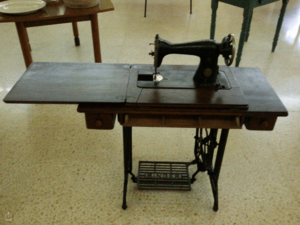
Singer's sales and profits grew until the 1940s. After World War II, the market changed. Other companies from Europe and Japan started making new types of sewing machines, like zig-zag machines. So, under the leadership of Donald P. Kircher, Singer decided to expand into other markets. They started making things like office equipment, defense products, and aerospace parts. Before this change, 90% of Singer's money came from sewing machines. After they diversified, only 35% did.
In the 1960s, Singer bought other companies. In 1965, they bought Friden, Inc., which made calculators. In 1968, they bought General Precision Equipment Corporation, which included companies that made things like flight simulators. Singer also made portable music and video equipment in the 1970s.
Recent History
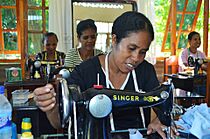
In 1978, Singer moved its main office from New York City to Stamford, Connecticut.
During the 1980s, Singer's sewing machine sales faced tough competition from Japanese and European brands. In 1986, Singer sold off its sewing machine business, which became a separate company called SSMC Ltd.
In 1987, a businessman named Paul Bilzerian took over Singer. To get his money back, he sold off different parts of the company. The sewing machine division was sold in 1989 to a company called Semi-Tech Microelectronics. Semi-Tech Global then bought SSMC and the rights to the Singer name, so SSMC became Singer again.
Singer N.V. went bankrupt in 1999 and was bought by Kohlberg & Company. In 2006, Kohlberg & Company, which owned Singer, also bought the Husqvarna and Pfaff brands. These three brands joined together to form the SVP Group, which owns Singer today. Singer's main competitors include Baby Lock, Bernina, Brother, Janome, Juki, and Aisin Seiki.
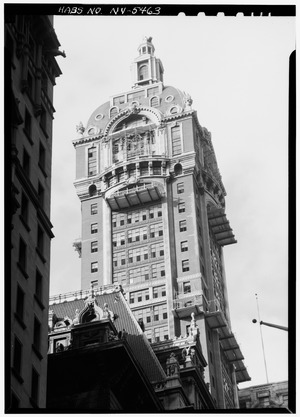
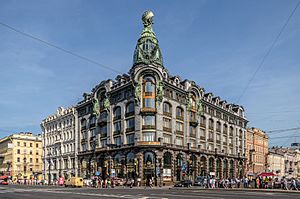
Singer was also involved in building in Manhattan in the 1800s, thanks to Edward C. Clark, one of the company's founders. Clark built famous buildings like The Dakota apartments. In 1900, Singer hired an architect to build a 12-story building in Lower Manhattan, which is now considered very important for its architecture.
The 47-story Singer Building, finished in 1908, was also designed by the same architect. When it was built, it was the tallest building in the world! It was the tallest building ever taken down on purpose until the Twin Towers of the World Trade Center were destroyed in the September 11 attacks.
At their Clydebank factory in Scotland, Singer built a 200-foot clock tower. It was known as the largest four-faced clock in the world. Each clock face weighed five tons! The tower was taken down in 1963, and the factory closed in 1980. The Singer railway station, built for the factory, is still used today and is one of only two train stations in the UK named after a factory.
The famous Singer House in Saint Petersburg, Russia, was built from 1902 to 1904 as the headquarters for Singer's Russian branch. This beautiful building is now recognized as an important historical and cultural site in Russia.
In 2017, Singer launched a new app called the Singer Sewing Assistant App.
In 2018, a large factory fire destroyed a Singer office and warehouse in Seven Hills, Sydney, Australia. Singer used to make sewing machines in Australia at a special factory in Penrith from 1959 to 1967.
Leaders of the Company
Here is a list of the people who led the Singer company over the years:
- Isaac M. Singer (1851–1863)
- Inslee Hopper (1863–1875)
- Edward C. Clark (1875–1882)
- George Ross McKenzie (1882–1889)
- Frederick Gilbert Bourne (1889–1905)
- Sir Douglas Alexander (1905–1949)
- Milton C. Lightner (1949–1958)
- Donald P. Kircher (1958–1975)
- Joseph Bernard Flavin (1975–1987)
- Paul Bilzerian (1988–1989)
- Iftikhar Ahmed (1989–1997)
- Stephen H. Goodman (1998–2004)
Popular Singer Sewing Machines for Home Use
See also
- History of the sewing machine
- List of sewing machine brands




